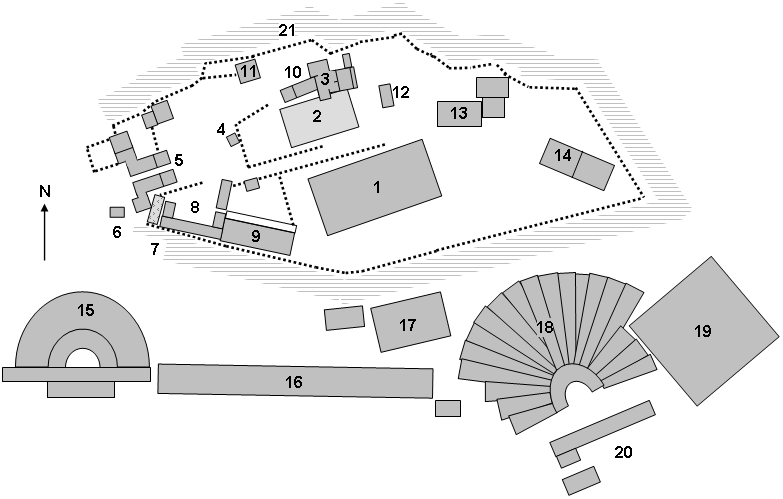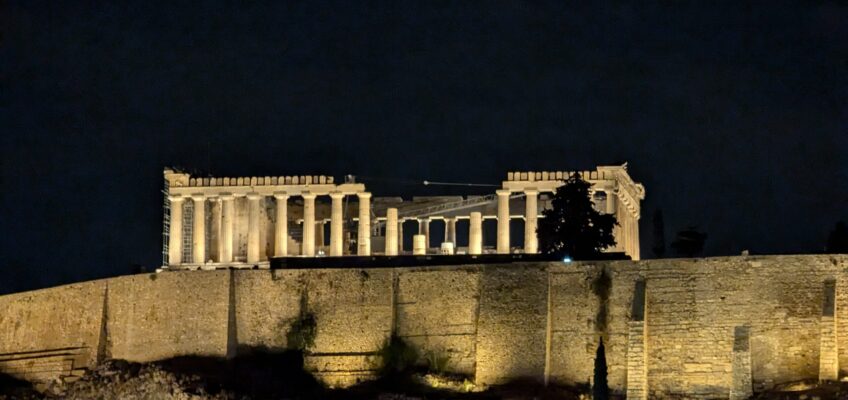I had just about a day and a half in Athens. I arrived Sunday afternoon and left before dawn on Tuesday morning. It was a whirlwind visit.
That’s okay. There was not really all that much to see. Athens is a one-trick pony. It’s a pretty damn good trick, but having seen it, I don’t think there’s much else worth sticking around for.
As usual, I took plenty of photos. Here they are.
Tour pre-trip
Monday was the first day of the pre-trip extension for the OAT tour I’m taking: Ancient Lands of Alexander the Great. The main part of the tour is northern Greece, Albania, and North Macedonia. The pre-trip extension is to Crete, but with one day in Athens.
There are just five of us on the pre-trip. Ten others will be joining us for the main tour. We have a really nice small group, and I’m enjoying hanging out with them (so far).
Arrival
I took a taxi from the airport to the Hera Hotel, where we were staying. On the way I mentioned to the driver what our itinerary is. When I mentioned that we’re going to North Macedonia, he responded, “Don’t go to Fake Macedonia.” He went on to insult them for being Slavic and not Greek.
Petros, our Trip Experience Leader (TEL) was waiting to meet me when I arrived at the hotel, and he took me and Sue, who had already arrived, on a short orientation walk. Then Sue and I continued to Syntagma Square, where the Greek Parliament is located, and we watched the changing of the guard. It was fun watching them march (rather comically), but it went on for ten minutes and actually got to be pretty boring.
Then we walked through Plaka, the main shopping (and tourist) area. For dinner we met the other three, a married couple and a single friend of theirs and went to one of the many touristic restaurants in the neighborhood.
Athens’ One Trick
The Acropolis
Yesterday we walked up to the Acropolis with a local guide named Ares, who did a great job of telling us what we were seeing. It was a mass of humanity. Impressive ruins that the whole world seems to want to see at the same time.
Here’s some of what’s there today:

1: The Parthenon
The Parthenon was built in the 5th century BC in thanksgiving for the Hellenic victory over Persian Empire invaders during the Greco-Persian Wars. Construction started in 447 BCE and was completed in 438 BCE; work on the artwork and decorations continued until 432 BCE. In the late 6th century CE, the Parthenon was converted into a Christian church dedicated to the Virgin Mary. After the Ottoman conquest in the mid-15th century, it became a mosque.
3. Erechtheion
This temple was constructed between 421 and 406 BCE. Little is known about its original purpose or interior design, but it may have been used for worship of Athena and Poseidon. It’s design is unique because its shape is asymmetrical. The porch at left, known as the Porch of the Maidens, had six sculpted female figures, known as Caryatids, as supports. Five of these are in the Acropolis Museum; the sixth is in the British Museum. The actual site shown above has replicas.
There is another, larger portico on the other side.
5. Propylaia
Built between 437 and 432 BCE, the Propylaia was the ceremonial gateway to the Acropolis.
What’s left of it is still the gateway to the Acropolis, but rather than ceremonial, it’s mobbed with tourists.
6. Temple of Athena Nike
Nike was the goddess of victory in Greek mythology, and Athena was worshiped in this form. The citizens worshiped the goddesses in hopes of a successful outcome in the Peloponnesian War.
Built around 420 BCE, the Temple of Athena Nike is the earliest fully Ionic temple on the Acropolis. Because of its position on a steep bastion adjacent to the Propylaia, it is prominently in view from below, even though it is quite small.
15. Odeon of Herodes Atticus
Built in 161 CE by Herodes Atticus in memory of his Roman wife, Aspasia Annia Regilla, the Odeon was a concert hall with a capacity of 5,000. It had a three-story stone front wall and a wooden roof made from cedar of Lebanon. It lasted intact until it was destroyed and left in ruins in 267 CE.
In the 1950s the Odeon was renovated. Among those who have performed here are Maria Callas, Frank Sinatra, and Luciano Pavarotti. The Miss Universe Pageant took place here in 1973. The Odeon is currently used as the primary venue for the Athens Epidarus Festival.
18. Theatre of Dionysus
Sitting on the south slope of the Acropolis, this theatre’s construction took place between the 6th and 4th centuries BCE. When completed, it had a capacity of 25,000. It continued to be used in the Roman period, but then it fell into decay. It was not excavated and restored to its current condition until the 19th century.
This is where the works of Aeschylus, Sophocles, Aristophanes and Euripides saw their original performances.
The Acropolis Museum
From there we went to the Acropolis Museum. I liked this museum, even though I’m not usually a fan of museums that display a lot of ancient artifacts. But everything was presented in interesting ways; you could get a sense of how the Parthenon and other ruins on the Acropolis would have looked before they were looted and then blown up by the Venetians. (Yes, the Venetians actually blew up the Parthenon. In 1687, during their war against the Ottomans, they laid siege to the Acropolis. The Turks used the Parthenon as a gunpowder store, and the Venetian army, well aware of this, shot mortars into the Parthenon, causing a huge explosion that destroyed the roof and most of the walls.) (Yes, the Parthenon originally had a roof and walls.)
The museum had a life-size model of the Parthenon (not full size, but big enough so you could walk through). It displayed many of the friezes that originally lined the walls of the Parthenon. Most of these were replicas; most of the originals are in the British Museum. (Yes, the British pilfered most of the sculpture that was part of the Acropolis. A Scotsman named Thomas Bruce, 7th Earl of Elgin, known as Lord Elgin, led a team that procured a huge number of the friezes and other sculptural elements from the Parthenon, in addition to a Caryatid and a column from the Erechtheion and sculptured slabs from the Athenian temple of Athena Nike. Lord Elgin sold the marbles to the British government, and they went on display in the British Museum in 1817. Greece has disputed Britain’s ownership of the Elgin Marbles, and the two countries have been in talks for several years about their future. Ares talked about “when” — not “if” — the marbles are returned to Athens.)
The Acropolis Museum also has a number of prehistoric artifacts. There were civilizations on the Acropolis that predate the ancient Greeks by millennia. Artifacts from as far back as the Neolithic era, around 6000 BCE, are on display. (Photos were not allowed in that section of the museum.)
Medea and Other Friends I Made in Athens
Theatre is a pretty important legacy of ancient Greece, right? So going to the theatre in Athens is an important way to honor that legacy, right? And it should be really good, right?
Right, right, and wrong.
The show, Medea and Other Friends I Made in Athens, was goofy, silly, and not something I’d recommend to friends and family who visit Athens. It consisted of excerpts from six bits of ancient Greek drama loosely woven together by a ridiculous framing device. Surprisingly, it has great review, 4.7 out of 5 on Google. I’d give it a 3.


Leave a Reply